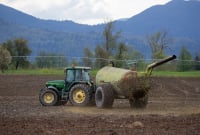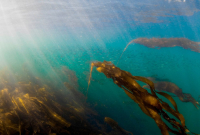In the 47 years Guy Johnston has worked as a fisher off British Columbia’s shores, he has watched friends and colleagues leave the trade as climate pressures mount.
Johnston is a prawn and salmon fisher based out of Cowichan Bay on Vancouver Island’s east coast who has also spent time harvesting crab. He says predicting salmon runs using Fisheries and Oceans Canada (DFO) estimates used to be straightforward. Within a small margin of error, scientists could generally say how big the runs would be, and therefore how much could be sustainably caught. Now, the swings in size are so dramatic that predictions are less and less accurate.
“In the past … 30 years, salmon runs [have] become much more erratic,” Johnston says, adding that in his time fishing, he’s seen both the largest and smallest salmon runs on record. “So that indicate[s] to me, things are changing,” Johnston says.
One of the factors driving the big swings is ocean acidification, the process of ocean waters absorbing CO2 gases from the burning of fossil fuels; when those gases mix with water they create carbonic acid. The increasing acidity harms marine life — including Johnston’s target species and many others — by dissolving shellfish shells, messing with fish development and senses, and much more.
Now, scientific research is expanding along the B.C. coast to better understand the effects of ocean acidification, and how to respond. In March, the B.C.-based Tula Foundation announced 11 grant recipients will be working on the problem locally — the result of a $1.7 million grant received last year, with just over $1.6 million going toward these projects.
One of the grant recipients is Timothy Green, a researcher at Vancouver Island University. His team was awarded $95,359 for their work to find genes that help oysters resist ocean acidification.
Shellfish commonly harvested in B.C., including oysters, mussels, prawns, crabs and scallops, make their shells out of calcium carbonate. Green says ocean acidification dissolves their shells faster than they can make them. This is critical in the early stages of life when shellfish need to make a shell before they can start feeding, or they will die and never reproduce.
“You're going to have recruitment failure of all these little organisms that attach to the rocks and then grow and do all these ecosystem services that are really important for us. It's a bit heartbreaking. …Luckily, the oyster that I worked with appears to be able to adapt to ocean acidification, but you wonder how that is going to play out in the long run,” Green says.
He says global pH of the ocean was measured at around 8.2 about 20 years ago, and has now dropped to 7.8, which is a lot on a scale that drops by 10 times for every point of increase or decrease. Green adds in certain areas of the Salish Sea on the east coast of Vancouver Island, pH levels are at times dropping to 7.5, an incredibly acidic environment that puts marine life, like shellfish, at risk.
The T Buck Suzuki Foundation is another team that received money from the program — $184,033 to use fishers as citizen scientists to create a baseline data set on ocean acidification levels in data-poor areas, like the west coast of Haida Gwaii.
The team is aiming to bridge the gap between harvesters and scientists, with fishers gathering data to send back to researchers to help solve some of the mysteries around what ocean acidification is doing in hard-to-reach places.
“We don't know what we don't know,” says Alaina Pyde, project lead for T Buck Suzuki Foundation. “We know that [ocean acidification] is a problem for any bivalve or calcifying organism… but does it spread out further than that?
The team will be sending three sets of equipment out with fishers near the end of August to early September — including Johnston. who is also a foundation board member.
“As a fisherman, I think it's important that we work with the scientific community to understand these issues. I think we're well positioned to be able to gather data in wide geographic areas, and I think also to be able to … share our insights from what we see at sea,” Johnston says.
“We spend a lot more time than scientists [do] at sea observing what is going on. Really, that's the nature of our job, is understanding and reading what's going on in natural systems.”
The grant money ultimately comes from the B.C. government’s Climate Ready B.C. Seafood Program, part of the Ocean Acidification and Hypoxia (BC OAH) Action Plan, programs the province announced with a focus on the effects on harvesting. But researchers also hope to take the opportunity to fill in knowledge gaps on ocean acidification on other marine ecosystems, and make the information available to inform decisions surrounding B.C.’s sensitive waterways.
“One really important thing is just having more people understand the impacts of ocean acidification and what's happening in our waters,“ says Nina Nichols, program manager with the Tula Foundation. “Commercial fishers, they're out on the water and experiencing the ocean every day, so it's great to engage them and have them involved in the scientific side of things as well.”






Comments